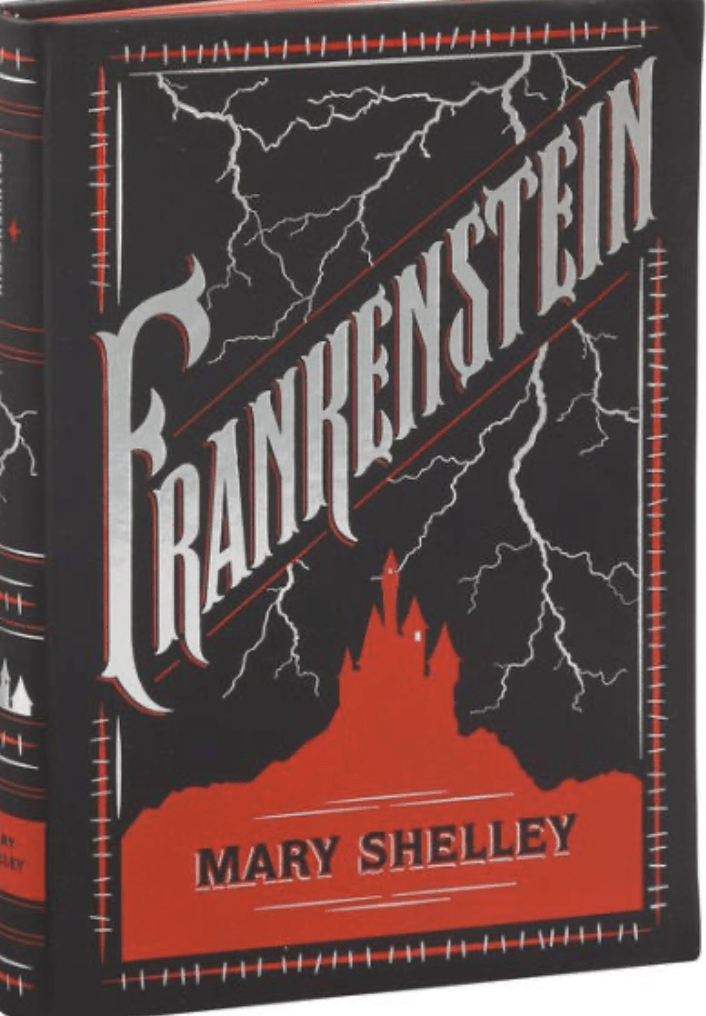Frankenstein
As the Halloween season rolls around, I often find myself in search of music, movies and books that can help bring the spooky season to life. Scary movies and The Rocky Horror Picture Show soundtrack tend to do the trick, but nothing satiates my thirst for Halloween spirit quite like the novel “Frankenstein” by Mary Shelley. This horrifying and thought-provoking gothic horror classic has withstood the tests of time and continues to shock readers since its conception within the nightmarish mind of 18-year-old Mary Shelley.
The story came to Shelley in a nightmare one night while on vacation in Switzerland with her husband and friends. After being confined to their villa due to the unrelenting stormy weather, the group was inspired to read horror stories and dark poems to pass the time. Soon, a competition was suggested among the group: to write a story scarier than the ones they had all read. And Mary would do just that.
The novel begins with a ship sailing out in the bitter cold of the Arctic in search of the North Pole. The sailors stumble upon an emaciated, weak man, traversing the ice and snow on dog-sled. They bring him aboard the ship, and he introduces himself as Victor Frankenstein. The novel continues as Victor tells the captain his life’s story and his greatest mistake that brought him to this point in his life.
As a young man attending university, Victor becomes fascinated, if not completely obsessed, with the sciences of life and death. After years of studying and research that often included digging up rotting corpses and analyzing their decay, Victor believes he has finally discovered the secret to life itself. Blinded by pride and drunk on godlike power, he fashions an eight-foot-tall, abhorrent humanoid creature out of decaying body parts and brings it to life. But unlike many modern-day adaptations, Victor does not triumphantly throw his hands in the air and manically cry, “It’s alive!” He rears back in horror and disgust at the monster before him and runs out into the night, abandoning his creation out of fear and realization of what he has done.
The monster follows suit and takes off into the forest, now exposed to the elements of nature and the elements of humanity. The monster begins to learn the intricacies of what it means to be alive and more specifically, what it means to be human. He learns to talk and read. He learns of love, hatred, kindness, history and religion, all while hiding in the cottage of a poor family. But he also learns through his interactions with others, which often end in them screaming and running from him, that human isn’t quite the word one would use to describe him. The monster is forever plagued by the grotesque nature of his appearance and the understanding that he is utterly alone in this world. Despite his own acts of kindness and attempts to fit in with civilization, humanity still fears him. Rage and envy boil inside of the monster towards his creator and towards mankind for their rejection of him, and he sets out to enact his revenge upon them both.
Mary Shelley creates a twisted web of social dilemmas and moral conundrums that leave the audience wondering to the very end: Who is the real monster of the story? The selfish scientist who let his own apathetic desires drive him to “play God” and create a monster? Or the monster who justifies his own evil actions by blaming them on the ignorance and prejudice of his creator and of society?
Every time I read this novel, I stay up even later at night, pondering the relationship between creator and creation. The themes of justice vs. revenge and nature vs. nurture are complex, and Shelley’s construction of them throughout the story make them even more difficult to rationalize. The novel takes readers on a wild ride of heartbreak and tragedy, while also inconspicuously prompting them to question their own values and morals.
What makes the story so horrifying isn’t only the imagery it conjures of a gruesome monster being created out of corpses and coming to life to murder innocent people. It is the haunting questions readers are left with, where they must decide for themselves what is good and what is evil. And what could be scarier than that? It is Mary Shelley’s spell-binding literary prose and ability to articulate what really keeps people up at night that keeps me coming back, Halloween after Halloween.


Having never read Frankenstein, this article provided a great summary and opinion on it. I find it interesting that the ultimate horror in this story is the idea of extreme limits humans can reach.